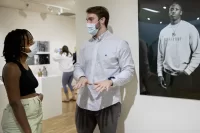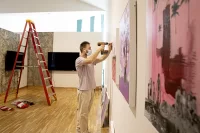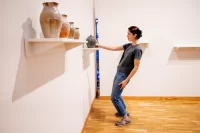
Seven senior art majors show work at Museum of Art
![]()
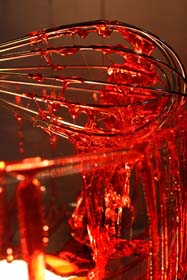 |
| Above: A untitled photograph from Melissa Shaw’s series “Horrifyingly Sweet.” Below: “Grand Study of Prud’hon’s Seated Female Nude” by Eugene Kim; “Route 202” by Rachel Harmeling; an untitled ceramic bowl by Sean VanderVliet. |
Seven studio art majors at Bates College show work from their yearlong thesis projects in the annual Senior Exhibition, which opens with a reception at 7 p.m. Friday, April 4, in the Bates College Museum of Art, 75 Russell St. The exhibition runs through May 24 in the museum’s Bates Gallery.
Opening at the same time is “The Kimono and Traditional Japanese Culture: Investigating Kimono through Ukiyo-e in the Bates College Art Museum Collection,” which runs through July 19 in the museum’s Synergy Seminar Gallery.
Open to the public at no cost, the museum’s regular hours are from 10 a.m. to 5 p.m. Tuesday through Saturday. For more information, please call 207-786-6158 or visit the museum Web site.
The Senior Exhibition artists are: Chad Casey, Gardiner; Elizabeth Fahy, Carrabassett Valley; Rachel Harmeling, North Reading, Mass.; Emily Hopkins, Warwick, R.I.; Eugene Kim, Hooksett, N.H.; Melissa Shaw, Cleveland; and Sean 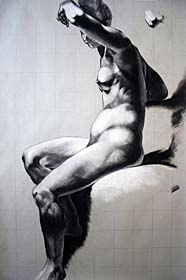 VanderVliet, Meriden, N.H.
VanderVliet, Meriden, N.H.
As required by the major, studio art students create a cohesive body of related works through sustained studio practice and critical inquiry. The yearlong process is overseen by faculty and culminates in this exhibition.
“My sense is that they begin to learn to work with independence and consistency,” says Robert Feintuch, senior lecturer in art and visual culture at Bates and adviser to the student artists. “We hope they learn to work both critically and productively.”Casey exhibits digital photographic prints. Working towards a graphic novel based on Franz Kafka’s “Metamorphosis,” he placed hand-drawn characters and other elements into a constructed bedroom and photographed them. His project, he says, is “motivated by a long-standing desire to illustrate a book, a love for macabre tales of decay and death, and my obsessive drawing style.”
In her monotypes, says Fahy “I concentrate on the face because it is the most telling and complicated part of the body. I am also working with the female figure because it is beautiful and challenging. I simplify the figure in my work because I am interested in the play between figuration and abstraction.”
 Harmeling‘s photographs examine the relationships between local bridges and their reflections and shadows. She is intrigued by the juxtaposition between the manmade and the natural, she says. “I shoot from viewpoints not ordinarily taken, to give the bridge a new character and try to find beauty in something unnoticed.”
Harmeling‘s photographs examine the relationships between local bridges and their reflections and shadows. She is intrigued by the juxtaposition between the manmade and the natural, she says. “I shoot from viewpoints not ordinarily taken, to give the bridge a new character and try to find beauty in something unnoticed.”
Using translucent and opaque papers, Hopkins creates images of trees and hands that suggest relationships between the human and the natural. “Tracing paper allows me to layer drawings so that I can have ghostlike images appear, partially visible behind the outer layers,” says Hopkins. Her aim is to “convey a sense of mystery and secrecy that calls for curious people to take a closer look.”
Kim, a double major in art and biology, creates figure studies based on the work of such French artists as Seurat and Prud’hon. “I treat the model as a landscape that I survey, measuring every detail in order to be precise and accurate,” he says. “I have worked exclusively from the human figure because of my strong interest in human physiology and anatomy.”
Shaw made large, abstract color-saturated digital photographs of still-lifes constructed from kitchen utensils, sugar and food coloring. “My photographs are beautiful, yet disturbing at the same time,” she says. “I love the idea that something as beautiful and sweet as sugar can feel so sinister.”
“For as long as I can remember my family has used handmade pottery in our 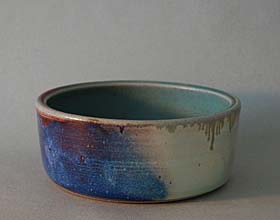 home,” says VanderVliet and his glazed stoneware explores the ancient tension between usable crafts and fine arts. “I just want to continue trying to walk the line between the kitchen and the gallery to see what develops,” he says. “The relationship between the shape, the tensions between rims and bases, and the color all work to make the form dynamic and whole.”
home,” says VanderVliet and his glazed stoneware explores the ancient tension between usable crafts and fine arts. “I just want to continue trying to walk the line between the kitchen and the gallery to see what develops,” he says. “The relationship between the shape, the tensions between rims and bases, and the color all work to make the form dynamic and whole.”
